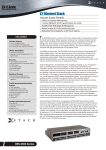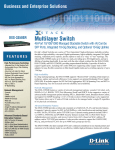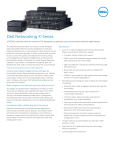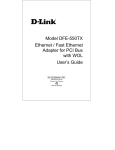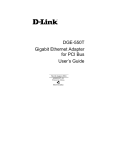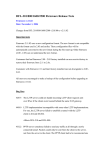Download D-Link xStack Specifications
Transcript
D-LinkTM xStackTM Switch Series Meeting the Need at the Edge of the Network White Paper October 2004 Abstract This white paper provides an overview of how the xStack Switch Series by D-Link Systems, Inc. implements state-of-the-art technology to address critical requirements at the edge of the network. Requirements such as the need for more density to support more users, but with the performance to ensure users get the bandwidth they require; the need to deploy services faster while lowering the cost of delivering these services and the need to secure the network while remaining open to new opportunities; and the need for 10-Gigabit switching capacity. The xStack Series delivers the industry’s best investment protection by implementing advanced hardware and software technology to meet and exceed these and other emerging edge switch requirements. D-Link xStack Switch Series: Meeting the Need at the Edge of the Network D-Link Systems, Inc. October 2004 1 Executive Summary The way in which businesses use LANs is changing and the performance requirement at the edge of the network is becoming more demanding. IP Telephony and other collaborative applications are driving more traffic to the edge of the network. As file sizes continue to grow, users need more bandwidth. Quite simply, the convergence of voice, video, data, and storage enables users to do more from their desktop. Enterprises need to be able to address today’s increased demands and still prepare for the unknown demands of tomorrow. By re-assessing how they’re using the wiring closet, they can achieve both goals, and be assured that their investments will be protected for a long time to come. With the xStack Multilayer Switch Series, D-Link meets the switching demands of growing medium and large businesses. The xStack Series is a line of Enterprise-class switching products that provide the industry’s highest density Gigabit connectivity, managed Layer 2 Ethernet switching, full-featured Layer 3 IP routing, robust security, advanced QoS, and blazing 10Gigabit support—all in one compact 1RU chassis. With strict adherence to industry open standards, xStack switches are designed and priced to help businesses build a cost effective, powerful, and professional network. Delivering the greatest Gigabit switch throughput performance in the industry, the D-Link xStack Series enables deployment of intelligent services faster and more efficiently than ever before. Even the most demanding customer can now have it all: investment protection for years to come, intelligence to support new services and simplify the network, and high availability features that will keep users connected and productive. Before we discuss the features and benefits of the D-Link xStack Series, it is important to first understand the current driving forces behind the demand for Gigabit and 10-Gigabit at the network edge. The Demand for Gigabit and 10-Gigabit Ethernet Frustrated network users, new bandwidth-intensive applications, rapid Gigabit rollouts, and falling prices are making 10-Gigabit Ethernet a necessity in the Enterprise network. With 10Gigabit Ethernet, bandwidth-challenged Enterprises can meet their acute network needs with 10Gbps solutions that provide the benefits of Ethernet while preserving investments in 1-Gigabit Ethernet and 10/100Mbps Fast Ethernet LANs. Initially, Enterprises are using 10-Gigabit Ethernet on network segments that aggregate extremely high volumes of traffic, such as campus backbones and very high-speed links between supercomputer clusters, or between servers and switches in datacenters. By preserving Ethernet from end to end, such links leverage existing Enterprise infrastructures while lowering costs and simplifying training and network management. Furthermore, Enterprises can deploy the 10-Gigabit Ethernet links without worrying about compatibility problems, because the standard coming out of the IEEE 802.3ae working group preserves the IEEE 802.3 Ethernet frame format, minimum and maximum frame size, and media access control (MAC) client interface. This means that existing products from the leading vendors will support the new 10-Gigabit Ethernet standard. D-Link xStack Switch Series: Meeting the Need at the Edge of the Network D-Link Systems, Inc. October 2004 2 When used with single-mode optical fiber, 10-Gigabit Ethernet has an operating range of up to 40 miles. This operating range and its very high speed make 10-Gigabit Ethernet a viable alternative for linking large corporate LANs and for connecting datacenters, server farms, and storage area networks (SANs) within a campus or metropolitan area. By using Ethernet from end to end, such deployments can reduce costs, simplify training and management, and avoid potential problems with latency and other complications arising from converting between the Ethernet and Internet Protocol (IP). Deploying 10-Gigabit Ethernet gives Enterprises an edge over their competition by being able to support their existing data-intensive infrastructures while easing the burden on highly aggregated links with large over-subscription ratios. The deployment also quickly accommodates new initiatives in high-performance computing, server clustering, SANs, disaster recovery, streaming media, and multi-site collaboration. Additionally, by using 802.1p and 802.1q, 10-Gigabit Ethernet can deliver guaranteed levels of latency, jitter, and bandwidth, allowing Enterprises to integrate voice over IP, video, and other multimedia traffic on the network. With the growing number of bandwidth-intensive applications and the potential for 1Gbps links to desktops or small workgroups, there is an increasing need for 10Gbps connections to carry traffic on LAN backbones and elsewhere in the corporate network. Enterprises can feel comfortable deploying 10-Gigabit Ethernet now to meet these needs, knowing that it will work with existing Ethernet installations and bring reductions in operating costs without requiring any costly overhauls or high levels of sophistication. Gigabit to the desktop and 10-Gigabit uplinks back to the network core D-Link xStack Switch Series: Meeting the Need at the Edge of the Network D-Link Systems, Inc. October 2004 3 APPLICATIONS FUEL DEMAND FOR 10-GIGABIT ETHERNET Enterprises should consider deploying 10-Gigabit Ethernet as soon as possible, given that 1-Gigabit Ethernet is already migrating from servers at the core of the network to specialized workstations and is starting to reach desktops at the edge of the network. Equipment vendors are aggressively slashing prices for 1-Gbps equipment, primarily LAN switches, network interface cards (NICs), and LAN on motherboards (LOMs), further encouraging the use of 1Gbps connections. Price erosion is also being fueled by the advent of Gigabit-over-copper (1,000Base-T) technology, which allows Enterprises to use their existing Category 5 copper-based infrastructure while maintaining the robustness previously found only in fiber links. At the same time, 10Gbps versions of NICs are expected to deploy in servers soon. Enterprises will increasingly need the 10Gbps pipes for aggregation of 1Gbps connections and to support the growing number of bandwidth-intensive applications. Very high-speed connections are needed to accommodate the demand for more bandwidth between LAN switches and the desire to aggregate server farms at high speeds. The growing availability of gigabit-over-copper, the trend toward Gigabit-to-the-desktop connections, and the wider availability and use of highperformance computing, multi-site collaboration, streaming media, and videoconferencing are further swelling the demand for 10-Gigabit Ethernet connections. Another positive factor for 10-Gigabit Ethernet: it gives Enterprises a valuable option in a time of tight budgets. In such instances, firms may choose to install more bandwidth instead of immediately migrating LAN switches to prioritization, managed switches, and from Layer 2 to Layer 3. This has become known as "throwing bandwidth at a problem." It is not an elegant solution— or one to be recommended in large and complex networks— but it has worked for years where networks are relatively simple. Introduction to the xStack Switch Series The D-Link xStack Series represents the next generation in innovation and performance in a stackable solution. They offer scalable and resilient solutions for Gigabit and 10-Gigabit Ethernet, providing exceptional security features and support for enhanced convergence while minimizing capital and operational expenses. All the features typically found in the more expensive chassis-based solutions, at the price of a stackable. D-Link xStack Switch Series: Meeting the Need at the Edge of the Network D-Link Systems, Inc. October 2004 4 xStack Models xStack Series switches are designed to provide high-density Gigabit desktop connectivity and 10GbE to the core for mid-size and large Enterprise customers. xStack Switches are available in 4 models: xStack DGS-3324SR xStack DGS-3324SRi xStack DXS-3350SR xStack DXS-3326GSR § § § § § § § § § § § § § § 24-Port 10/100/1000Base-T 4-Port Combo SFP 2-Port 10GbE Stacking 24-Port 10/100/1000Base-T 8-Port Combo SFP Ports 6-Port 10GbE Stacking 48-Port 10/100/100 4-Port Combo SFP 2-Port 10GbE Stacking Ports Optional 10GbE XFP Support 24-Slot Gigabit SFP 4 Combo SFP Ports 2-Port 10GbE Stacking Optional 10GbE XFP Support D-Link xStack switches offer a scalable and resilient solutions for Gigabit and 10-Gigabit Ethernet D-Link xStack Switch Series: Meeting the Need at the Edge of the Network D-Link Systems, Inc. October 2004 5 xStack Series Benefits Industry’s highest density Gigabit Ethernet for easy scalability and efficient use of rack space. High Gigabit copper port-density in a stack: Star:312, Ring:384 40Gbps stacking bandwidth to minimize network latency and increase response times 120Gbps aggregated stacking bandwidth in star-stacking topology 8 priority queues of QoS on every port to optimize application performance in a converged network Advanced Layer 3 intelligence to roll out new services quickly and easily Comprehensive security services to protect your network where it's being attacked–at the network edge Highest performance switch fabric (176 Gbps*) and throughput (131Mpps*) so current and future applications have the bandwidth required Investment protection and operational simplicity resulting in low cost of ownership Modular 10-Gigabit Ethernet design that can be quickly upgraded in the field so you only pay for the bandwidth you need, when you need it Redundant hardware and special availability software ensure the highest level of network availability Two 10-Gigabit Ethernet ports to avoid the common uplink bottleneck from the wiring closet to back to the core * DXS-3350SR has a 176Gbp sswitching capacity and 131Mpps of throughput capacity. Refer to other xStack switches for individual performance specifications. xStack Layer 3 Intelligent Services - 8 priority queues Multicast Routing - IGMP v1/v2 - Layer 2 classification - 802.1P priority marking - IGMP snooping - PIM-SM, PIM-DM - Layer 3 DiffServ code points - Bandwidth rate limiting Network Address Translation Security Features - Layer 2/3/4 Access Control Lists VLAN - Rate limiting - Layer 2/3/4 Access Control Lists - 4000 VLANs - 802.1Q VLAN tag - RADIUS support - TACACS+ support - Port-based and MAC-based VLANs Link Aggregation - 802.1x Network Authentication - 802.1X 16,000 MAC Address Table STP, RSTP, MSTP - SSH2 server - SSL Routing - SNMPv3 Management Features - RIP v1/v2 - Telnet - VRRP (Virtual Routing Redundancy Protocol) - OSPF - SYSLog - SNMP v1, 2, 2c - Static route - Port Mirroring (by port #) - 4 RMON groups per port QoS - HTML management D-Link xStack Switch Series: Meeting the Need at the Edge of the Network D-Link Systems, Inc. October 2004 6 Complete Solution for Mid-Sized Businesses & Enterprises Whether you need to bring Gigabit or just conventional 10/100Mbps speed to your organization's desktops, D-Link's xStack Series has the right solution with the right port types, port densities, and uplinks to match your requirements. xStack Switches support up to 16,000 MAC addresses, 4,000 Layer 3 forwarding database in hardware, or 64,000 routing table entries making this an ideal switch for both wiring closet implementations and enterprise branch offices. Even as the customer’s network grows, the large table sizes supported in xStack Switches make them an excellent long-term solution more than capable of supporting growth in the network. With industry-leading scalability and flexibility, each xStack 10/100/1000Mbps Gigabit switch may be joined in any combination to evolve with your network needs. Industry Leading 10/100/1000 Scalability The xStack Series delivers industry-leading 10/100/1000 density, scalability, and port flexibility, which allows customers to easily expand their network and make the most efficient use of available rack space. At just 1.75” (1 rack unit), one xStack switch can provide up to 48 Gigabit ports per switch. This gives you up to 312 Gigabit ports per stack in the star-stacking architecture, or a of maximum 384 Gigabit ports in a ring-stacking architecture. This high port density allows xStack Switches to be deployed either as a core switch or as an easily expandable stack for Gigabit-to-the-desktop applications. xStack’s high performance switching architectures will continue to be a critical edge solution in the customer’s network for years to come. 10-Gigabit Ethernet at the Edge–When You Need It D-Link's xStack Series provides 10-Gigabit uplinks for transmission at up to 10 times the speed of a 1-Gigabit port, up to 20,000Mbps in the full-duplex mode. 10-Gigabit uplinks means that the edge switch uplink capacity can grow as the end user’s bandwidth demands increase. Based on a modular design, an optional 10-Gigabit “daughter card” can be added to the xStack DXS-3350SR or DXS-3326GSR switch to deliver immediate support for two 10-Gigabit XFP transceivers. This advanced design enables the user to easily upgrade the xStack DXS-3350SR or DXS-3326GSR for multiple 10-Gigabit uplinks when increased capacity is required. Non-blocking Switching Capacity—Up to 176Gbps The xStack Series delivers industry-leading switch fabric and throughput performance giving users the bandwidth their applications require. The xStack 48-port DXS-3350SR has a 176Gbps switching capacity that is able to process up to 131 million packets per second, making it the industry’s highest performance fixed configuration edge switch available. This industry-leading performance ensures that the xStack switches will have the capacity to support ever-growing end user bandwidth requirements. Voice-Video-Data Convergence Many customers are starting to reduce their overall networking expenditures by converging their voice-video-data networks into a single network, and the xStack Series is an ideal solution for this convergence. The xStack Series supports up to 8 queues on every port to classify and prioritize traffic to ensure that high priority traffic, such as voice and video traffic, get the required bandwidth when it is needed. D-Link xStack Switch Series: Meeting the Need at the Edge of the Network D-Link Systems, Inc. October 2004 7 Layer 3 Wire-speed Packet Routing Layer 3 IP routing performed at the switch level offloads the routing burden handled by a network router, thus enabling the network to run more efficiently. xStack switch’s Layer 3 IP routing provides support for RIP v.1, v.2, OSPF, and DVMRP protocols performed by on-board ASICs at speeds many times faster than CPU-based routers. xStack switches provide wire-speed non-blocking switch fabrics with extremely fast hardware-based packet filtering/forwarding and instant support for Windows, Unix, and Internet environments. VLAN support VLANs can be established for each switch to extend the broadcast domain and segment network traffic. These VLANs can be spread among port-based or protocol-based VLANs. The VLANs can be on a standalone switch or across a stack. Protocol-based VLANs allow switch ports to be assigned to a broadcast domain based on the protocol information within the packet. These VLANs localize broadcast traffic and assure that the specified protocol type packets are sent only to the protocol-based VLAN ports. xStack switches have been designed to support up to 4,000 VLANs. xStack switches also support per VLAN Tagging option on each port. Multi-layer Quality of Service (QoS) Applied at the Edge xStack Switches implement a robust set of multi-layer (L2, L3, L4) QoS/CoS features to ensure that critical network services like VoIP, ERP, Intranet, and video conference are served with proper priority. Up to 8 priority queues for 802.1p/TOS/DiffServ are supported, with classification and marking based on MAC SA/DA, IP SA/DA, and/or TCP/UDP port numbers. QoS provides granular control where the user meets the network. This is particularly important for networks migrating to converged applications where differential treatment of information is essential. QoS is also necessary for the migration to Gigabit or 10-Gigabit Ethernet speeds, where congestion must be avoided. xStack switches use advanced QoS DiffServ and 802.1p (Class of Service) protocols to classify, prioritize, and mark LAN traffic as a way to efficiently use existing bandwidth and offer reliable connectivity for mission-critical applications and converged networks that are susceptible to bandwidth availability, system latency, and jitter. D-Link xStack Switch Series: Meeting the Need at the Edge of the Network D-Link Systems, Inc. October 2004 8 IGMP snooping xStack switches feature IP Multicast support by examining (‘snooping’) all Internet Group Multicast Protocol (IGMP) traffic in hardware at line rate, and pruning unwanted data streams from affecting network or end-station performance. Network performance will become more efficient and load processing can be reduced dramatically. Unicast Example Increased Server Processing Network Packet flow Multicast Example Efficient Multicast Network Multicast benefits server load Multiple Spanning Tree protocol groups The xStack Switch family supports multiple Spanning Tree Groups, either in a single standalone switch or distributed across a stack. Spanning Tree Groups provide multiple data paths which can be used for load-balancing, redundancy, and to prevent loops in a network. The switch architecture also supports IEEE 802.1s and 802.1w. High Availability Uplinks The xStack Series supports redundant copper and/or fiber Gigabit Ethernet uplinks and redundant 10-Gigabit Ethernet uplinks for not only the highest uplink capacity at the edge, but also the greatest redundancy. If any single uplink port is not available, a xStack switch can automatically failover to the redundant port for maximum resiliency and connectivity. The result is true high availability--the user stays connected to the network and remains productive. Extensive Network Management Functions xStack Switches support a variety of network management options including: console CLI, Telnet configuration, Web-based and SNMP v.1/v.2c/v.3 management, RMON monitoring, TFTP firmware upgrade, Port Mirroring for troubleshooting, BootP, and DHCP IP assignment. The xStack also supports a variety of advanced traffic management options including: 802.1x, Bandwidth Control, Broadcast Storm Prevention, and support for IGMP v.1, v.2 snooping. D-Link xStack Switch Series: Meeting the Need at the Edge of the Network D-Link Systems, Inc. October 2004 9 Comprehensive Security D-Link's xStack Series provides a complete set of security features for connectivity and access control. The features includes Access Control Lists (ACLs) based on MAC address, switch port, IP address, and/or TCP/UDP port numbers, 802.1x user authentication and MAC address control. The xStack also provides central management for administration access via TACACS/TACACS+ and RADIUS. Together with network application control, this security ensures that not only proper user access is served, but malicious traffic is also prevented from spreading across the network. Network Login and 802.1x Every user on every port can be authenticated so the network is protected at the most common point of attack, the edge. xStack Series switches can immediately reject users not authorized to enter the switch or network. Unauthorized users cannot cause problems in the network because they are unable enter the network and therefore cannot enter the network unless authorized by the xStack switch’s web-based or 802.1x based Network Login security features. xStack Network Login and 802.1x secure the edge of the network Wire Speed Access Control Lists (ACLs) ACLs are powerful security tools and the use of ACLs in networks is likely to increase as a way to combat security threats. However, the value of ACLs is diminished if, by applying them, traffic slows down, creating a congestion point. The xStack Series delivers wire speed ACLs on every port for maximum security while maintaining maximum throughput. With xStack Series switches an IT manager can turn on ACLs whenever they are needed without worrying about disrupting business applications or reducing productivity. D-Link xStack Switch Series: Meeting the Need at the Edge of the Network D-Link Systems, Inc. October 2004 10 Secure Shell 2 (SSH2) xStack Switches support SSH2 to securely transfer switch configurations and images into and out of the switch. To fix the known limitations in SSH, it is critical that customers use the latest SSH2 as supported in the xStack Series. Virtual Router Redundancy Protocol (VRRP) Support D-Link's xStack supports Virtual Router Redundancy Protocol (VRRP), allowing several Layer 3 switches on a multi-access link to utilize the same virtual IP address. VRRP support provides convenience, permitting your host system to be configured manually or via DHCP with a single default gateway. VRRP is used in the D-Link DES-6500 and the xStack Series Switch products for high availability. Each subordinate switch with routing capability is initialized and ready to take over routing functions if the master fails. Each subordinate switch is fully initialized and connected to the master. The subordinates have identical interface addresses, encapsulation types, and interface protocols and services. The subordinate switches continually receive and integrate synchronized configuration information sent by the current master and monitor their readiness to operate through the continuous execution of self-tests. Re-establishment of routes and links happens more quickly than in normal Layer 3 devices because of the lack of time needed to initialize the routing interfaces. Multiple Mechanisms for High Availability The D-Link xStack technology supports a variety of mechanisms for creating high resiliency in a stack. • • • • • Cross-Stack Link Aggregation technology—Multiple switches in a stack can create an link aggregation connection. Loss of an individual switch will not affect connectivity for the other switches. Master redundancy—Every switch in the stack can act as the master. If the current master fails, another master is elected from the stack. Stacking cable resiliency—When a break in the bi-directional loop occurs, the switches automatically begin sending information over the half of the loop that is still intact. If the entire 40Gbps of bandwidth is being used, QoS mechanisms will control traffic flow to keep jitter and latency-sensitive traffic flowing while throttling lower priority traffic. Distributed Layer 2 forwarding—In the event of a master switch failure, individual switches will continue to forward information based on the tables they last received from the master. VRRP for Layer 3 resiliency—Each switch is initialized for routing capability and is ready to be elected as master if the current master fails. Subordinate switches are not reset so that Layer 2 forwarding can continue uninterrupted. D-Link xStack Switch Series: Meeting the Need at the Edge of the Network D-Link Systems, Inc. October 2004 11 Jumbo frame support for larger file applications Jumbo frame support of up to 9,216 bytes is supported, making the xStack Series ideal switches for new applications requiring large frames such as storage and graphic/video applications. Network data will stream more efficiently and processing load can be reduced dramatically. Rate Limiting The central flow control rate limiting feature in the xStack Series adds a valuable tool for bandwidth management on ingress traffic. Similar to an Access Control List, the rate limiting feature inspects incoming packets headers to allocate a predefined amount of bandwidth for that traffic flow. If the flow exceeds the assigned bandwidth, excess packets are either dropped or modified by resetting their DiffServ code point. Rate limits can be configured from 1 Mbps in 1 Mbps increments up to full line rate. Rate limiting is an excellent method of managing and prioritizing the total traffic coming into a switch and it also enables control of the amount of bandwidth any port, user, or application is allowed to consume. Centralized and Simplified Configuration D-Link’s xStack Series simplifies and centralizes your network management tasks, as multiple switches can be configured, monitored and maintained with one single IP address from any workstation running a Web browser. The stack is managed as a single entity, and all stacked units are identified by a single IP address. A simple yet powerful Web-based interface allows you to perform most comprehensive management and configuration tasks, eliminating the need for you to install expensive, complex SNMP network management software. Redundant Power System The xStack Series offers a Redundant Power System, which supports multiple xStack switches all with full power simultaneously. This power system provides 1-for-1 power back-up for every xStack unit connected. No more worrying about inadequate power if more than a single switch fails; the External Power System provides full redundant power for every xStack switch. The Redundant Power System automatically senses when the internal power supply has failed and immediately provides redundant power to the switch, preventing any loss of data. Removable Flash Memory System The innovative removable flash memory system of the DGS-3324SRi dramatically simplifies complex deployments, upgrades, backups, and replacement sparing. Save your configuration file on any standard flash memory card then eject the flash memory card for easy transportation. Cluster Network Management Feature The xStack Series also supports D-Link’s SIM (Single IP Management) Clustering Technology software. By utilizing SIM Clustering Technology, up to thirty-two D-Link SIM-capable switches—xStack or non-xStack switches—can be stacked logically and centrally managed through a single IP address. SIM Clustering Technology is not limited to the xStack Series, any physical location, or any specific stacking cables. Any D-Link switch that supports SIM Clustering Technology can become a member of a SIM cluster or virtual stack. SIM members D-Link xStack Switch Series: Meeting the Need at the Edge of the Network D-Link Systems, Inc. October 2004 12 can be located in different physical locations in a network. For example, SIM-capable switches can be located across a single building connected through industry-standard copper cables, or in different buildings across campuses connect by industry-standard fiber cables. A built-in Web manager with the SIM Clustering software provides a Tree View of the network, with clear information about the members of the switch cluster, the network topology displays the locations of the stacked units, and their link information. Support of SIM Clustering in the xStack Series enables you to expand beyond the physical stack and to include other D-Link switches to accommodate your future network requirement or growth. (Refer to product manuals to learn more about D-Link SIM Clustering Technology.) Tree View: SIM software provides clear information about the members of the virtual stack Topology View: SIM software illustrates the network map and link information Note: D-Link xStack switches can also be managed through D-Link D-View SNMP software. D-Link xStack Switch Series: Meeting the Need at the Edge of the Network D-Link Systems, Inc. October 2004 13 xStack Technology Overview The D-Link xStack technology provides an innovative new method for collectively utilizing the capabilities of a stack of switches. Individual switches intelligently join to create a single switching unit. Configuration and routing information is shared by every switch in the stack, creating a single switching unit. Switches can be added and deleted from a working stack without affecting performance. The Stack Interconnect Functionality D-Link xStack Technology unites up to twelve individual D-Link xStack switches into a single logical unit, using special stack interconnect cables and stacking software. The stack behaves as a single switching unit that is managed by a master switch elected from one of the member switches. The master switch automatically creates and updates all the switching and optional routing tables. A working stack can accept new members or delete old ones with minor service interruption. Bidirectional Flow—Fail-Safe Ring-Stacking A key differentiator for xStack Switches is their resilient stacking feature. xStack Switches can stack up to 12 units with a cascade stacking design, assuring continuous uptime even if a single switch in the stack should fail. A loop-back or cascade cable is used to seamlessly connect the entire stack to provide no single point of failure. In the unlikely event of a switch failure, traffic performance is maintained at 20Gbps on the immediate units on either direction of the failed unit via a ‘wrapping’ method; the remaining units in the stack continue to send traffic bi-directionally at full bandwidth capability of 40Gbps per switch. When a break is detected in a cable, the traffic immediately loops back across the single remaining 20Gbps path to continue forwarding. Whenever a frame is ready for transmission onto the path, a calculation is made to see which path has the most available bandwidth. The entire frame is then copied onto this half of the path. Traffic is serviced depending upon its class of service (CoS) or differentiated services code point (DSCP) designation. Low latency traffic is given priority. 1. Number of units in a stack may vary depending of xStack model D-Link xStack Switch Series: Meeting the Need at the Edge of the Network D-Link Systems, Inc. October 2004 14 D-Link xStack Technology Bi-directional Fail-Safe Stacking Bi-directional fail-safe stack architecture. Stack Up to 12 units in a Ring topology Stack up to 7 units in a Star topology. Subsecond Failover in Ring-Stacking Within microseconds of a breakage of one part of the path, all data is switched to the active half of the bi-directional path. The switches continually monitor the stack ports for activity and correct data transmission. If error conditions cross a certain threshold, or there is insufficient electromagnetic contact of the cable with its port, the switch detecting this then sends a message to its nearest neighbor opposite from the breakage. Both switches then divert all their traffic onto the remaining good path. Single Management IP Address The stack receives a single IP address as a part of the initial configuration. After the stack IP address is created, the physical switches linked to it become part of the master switch group. D-Link xStack Switch Series: Meeting the Need at the Edge of the Network D-Link Systems, Inc. October 2004 15 When connected to a group, each switch will use the stack IP address. When a new master is elected, it uses this IP address to continue interacting with the network. Stack Creation and Modification Stacks are created when individual switches are joined together with stacking cables. When the stack ports detect electromechanical activity, each port starts to transmit information about its switch. When the complete set of switches is known, the stack elects one of the members to be the master switch, which will be responsible for maintaining and updating configuration files, routing information, and other stack information. The entire stack will have a single IP address that will be used by all the switches. Master Redundancy Master redundancy allows each stack member to serve as a master, providing the highest reliability for forwarding. Each switch in the stack can serve as a master, creating a 1:N availability scheme for network control. In the unlikely event of a single unit failure, all other units continue to forward traffic and maintain operation. Master Switch Election The stack behaves as a single switching unit that is managed by a master switch elected by a network manager or automatically from one of the member switches. The master switch automatically creates and updates all the switching and optional routing tables. Any member of the stack can become the master switch. Upon installation, or reboot of the entire stack, an election process occurs among the switches in the stack. There is a hierarchy of selection criteria for the election. 1. User priority—The network manager can select a switch to be master. 2. MAC address—Each switch reports its MAC address to all its neighbors for comparison. The switch with the lowest MAC address is selected. Master Switch Activities The master switch acts as the primary point of contact for IP functions such as Telnet sessions, pings, command-line interface (CLI), and routing information exchange. The master is responsible for downloading forwarding tables to each of the subordinate switches. Multicast and unicast routing tasks are implemented from the master. QoS and access control list (ACL) configuration information is distributed from the master to the subordinates. When a new subordinate switch is added, or an existing switch removed, the master will issue a notification of this event and all the subordinate switches will update their tables accordingly. Shared Network Topology Information The master switch is responsible for collecting and maintaining correct routing and configuration information. It keeps this information current by periodically sending copies or updates to all the subordinate switches in the stack. D-Link xStack Switch Series: Meeting the Need at the Edge of the Network D-Link Systems, Inc. October 2004 16 Subordinate Switch Activities Each switch has tables for storing its own local MAC addresses as well as tables for the other MAC addresses in the stack. The master switch keeps tables of all the MAC addresses reported to the stack. The master also creates a map of all the MAC addresses in the entire stack and distributes it to all the subordinates. Each switch becomes aware of every port in the stack. This eliminates repetitive learning processes and creates a much faster and more efficient switching infrastructure for the system. Subordinate switches keep their own spanning trees for each VLAN that they support. The master switch keeps a copy of all spanning tree tables for each VLAN in the stack. When a new VLAN is added, or removed, all the existing switches will receive a notification of this event and update their tables accordingly. Subordinate switches wait to receive copies of the running configurations from the master, and begin start transmitting data upon receipt of the most current information. This ensures that all the switches will use only the most current information and that there is only one network topology used for forwarding decisions. Adding New Members When the switching stack has established a master, any new switch added afterward automatically becomes a subordinate. All the current routing and addressing information is downloaded into the subordinate so that it can immediately begin transmitting traffic. Its ports become identified with the IP address of the master switch. Global information, such as QoS configuration settings, is downloaded into the new subordinate member. Upgrades Apply to All Devices in the Stack Because the switch stack behaves like a single unit, upgrades apply universally to all members of the stack at once. This means that the first time a D-Link software upgrade is applied, all units in the stack will take on the characteristic of the image applied. All D-Link switch software upgrades are free of charge. Cross-Stack Link Aggregation Connections Because all the ports in a stack behave as one logical unit, Link Aggregation can operate across multiple, physical devices in the stack. D-Link Software can aggregate up to eight separate physical ports from any switches in the stack into one logical channel uplink. Up to 32 Link Aggregation groups are supported per stack. D-Link xStack Switch Series: Meeting the Need at the Edge of the Network D-Link Systems, Inc. October 2004 17 Summary The D-Link xStack Switch Series provides Gigabit and 10-Gigabit speeds with advanced switching features to increase the resiliency and the versatility of any network edge. With the xStack Multilayer Switch Series, D-Link meets the switching demands of growing medium and large businesses. The xStack Enterprise-class switching products provide the industry’s highest density Gigabit connectivity, managed Layer 2 Ethernet switching, full-featured Layer 3 IP routing, robust security, advanced QoS, and blazing 10-Gigabit support—all in one compact 1RU chassis. With strict adherence to industry open standards, xStack switches are designed and priced to help businesses build a cost effective, powerful, and professional network. Delivering the greatest Gigabit switch throughput performance in the industry, the D-Link xStack Series enables deployment of intelligent services faster and more efficiently than ever before. The most demanding customer can now have it all: investment protection for years to come, intelligence to support new services and simplify the network, and high availability features that will keep users connected and productive. With 10-Gigabit Ethernet, bandwidth-challenged Enterprises can meet their acute network needs with 10Gbps solutions that provide the benefits of Ethernet while preserving investments in 1-Gigabit Ethernet and 10/100Mbps Fast Ethernet LANs. The support of these advanced features improves the network convergence of voice, video, data, and storage, enabling users and managers to get an edge on the competition. D-Link xStack Switch Series: Meeting the Need at the Edge of the Network D-Link Systems, Inc. October 2004 18 xStack Multilayer Stackable Gigabit Switches DGS-3324SRi DXS-3326GSR 24-Port L3 Gigabit Star-Stacking MasterSwitches & 24-Port L3 Gigabit Switch 24-Port 10/100/1000BASE-T Ports 8-Port Combo SFP 6-Port 10GbE Stacking 1-Slot Compact Flash to store configuration file 24 SFP 4-Port Combo SFP 2-Port 10GbE Stacking 10GbE Uplink Module (optional) DGS-3324SR 24-Port L3 Gigabit Switch DEM-420X Optional 10G Uplink Module 24-Port 10/100/1000BASE-T Ports 4-Port Combo SFP 2-Port 10GbE Stacking 10GbE Module with two XFP slots DXS-3350SR 50-Port L3 Gigabit Switch Up to 300m 48-Port 10/100/1000BASE-T Ports 4-Port Combo SFP 2-Port 10GbE Stacking 10GbE Uplink Module (optional) DEM-421XT 10-Gigabit Ethernet XFP DEM-422XT 10-Gigabit Ethernet XFP Up to 10Km D-Link xStack Switch Series: Meeting the Need at the Edge of the Network D-Link Systems, Inc. October 2004 19 Offices U.S.A. D-Link Systems, Inc. 17595 Mt. Herrmann, Fountain Valley, CA 92708, USA TEL: 1-714-885-6000 FAX: 1-866-743-4905 URL: www.dlink.com Australia D-Link Australasia 1 Giffnock Avenue, North Ryde, NSW 2113, Sydney, Australia TEL: 61-2-8899-1800 FAX: 61-2-8899-1868 URL: www.dlink.com.au Belgium D-Link Belgium Rue des Colonies 11, B-1000 Brussels, Belgium TEL: 32 (0)2 517 7111 FAX: 32 (0)2 517 6500 URL: www.dlink-benelux.com Brazil D-Link Brasil Ltda. Av das Nações Unidas, 11857, cj 132 - Brooklin Novo, São Paulo, Brasil 04578-000 TEL: (55 11) 5503-9320 FAX: (55 11) 5503-9321 URL: www.dlink.com.br Canada D-Link Canada 2180 Winston Park Drive, Oakville, Ontario, L6H 5W1 Canada TEL: 1-905-829-5033 FAX: 1-905-829-5223 URL: www.dlink.ca Chile D-Link South America (Sudamérica) Isidora Goyenechea 2934 Oficina 702 Las Condes Fono 2323185, Santiago, Chile TEL: 56-2-232-3185 FAX: 56-2-232-0923 URL: www.dlink.cl China D-Link China Room 507/508, Tower W1, The Towers, Oriental Plaza No. 1 East Chang An Ave., Dong Cheng District, Beijing, 100738, China D-Link xStack Switch Series: Meeting the Need at the Edge of the Network D-Link Systems, Inc. October 2004 20 TEL: (86-010) 85182533 FAX: (86-010) 85182250 URL: www.dlink.com.cn Denmark D-Link Denmark Naverland 2, DK-2600 Glostrup, Denmark TEL: 45-43-96-90-40 FAX: 45-43-42-43-47 URL: www.dlink.dk Egypt D-Link Egypt 19 El-Shahed Helmy, El Masry, Al-Maza, Heliopolis, Cairo, Egypt TEL: 202-41-44-295 FAX: 202-41-56-704 URL: www.dlink-me.com Finland D-Link Finland Pakkalankuja 7A, 3rd floor, 01510 Vantaa, Finland TEL: 358-9-2707-5080 FAX: 358-9-2707-5081 URL: www.dlink.fi France D-Link France Le Florilege, No. 2, Allée de la Fresnerie, 78330 Fontenay le Fleury, France TEL: 33-1-3023-8688 FAX: 33-1-3023-8689 URL: www.dlink-france.fr Germany D-Link Central Europe (D-Link Deutschland GmbH) Schwalbacher Strasse 74, D-65760 Eschborn, Germany TEL: 49-6196-77990 FAX: 49-6196-7799300 URL: www.dlink.de India D-Link India D-Link House, Kurla-Bandra Complex Rd., Off Cst Rd., Santacruz (East), Mumbai, 400 098 India TEL: 91-022-652-6696/6578/6623 FAX: 91-022-652-8914/8476 URL: www.dlink.co.in & www.dlink-india.com Israel D-Link Israel 11 Hamanofim Street, Ackerstein Towers, Regus Business Center P.O.B. 2148, Hertzelia-Pituach 46120, Israel TEL: 972-9-9715700 FAX: 972-9-9715601 URL: www.dlink.co.il D-Link xStack Switch Series: Meeting the Need at the Edge of the Network D-Link Systems, Inc. October 2004 21 Italy D-Link Mediterraneo Srl/D-Link Italia Via Nino Bonnet n. 6/B, 20154, Milano, Italy TEL: 39-02-2900-0676 FAX: 39-02-2900-1723 URL: www.dlink.it Netherlands D-Link Netherlands Weena 290, 3012 NJ Rotterdam, The Netherlands TEL: 31 (0)10 282 1445 FAX: 31 (0)10 282 1331 URL: www.dlink-benelux.com Norway D-Link Norway Karihaugveien 89, N-1086 Oslo TEL: 47-23-89-71-89 FAX: 47-22-30-90-85 URL: www.dlink.no Russia D-Link Russia Grafsky per., 14, floor 6, Moscow 129626 Russia TEL: 7 (095) 744-0099 FAX: 7 (095) 744-0099 #350 URL: www.dlink.ru Singapore D-Link International 1 International Business Park, #03-12 The Synergy, Singapore 609917 TEL: 65-6774-6233 FAX: 65-6774-6322 URL: www.dlink-intl.com South Africa D-Link South Africa Einstein Park II, Block B, 102-106 Witch-Hazel Avenue Highveld Technopark, Centurion, Gauteng, Republic of South Africa TEL: 27-12-665-2165 FAX: 27-12-665-2186 URL: www.d-link.co.za Spain D-Link Iberia C/Sabino de Arana, 56 Bajos, 08028 Barcelona, Spain TEL: 34 93 409 0770 FAX: 34 93 491 0795 URL: www.dlink.es Sweden D-Link Sweden D-Link xStack Switch Series: Meeting the Need at the Edge of the Network D-Link Systems, Inc. October 2004 22 P. O. Box 15036, S-167 15 Bromma, Sweden TEL: 46-(0)8564-61900 FAX: 46-(0)8564-61901 URL: www.dlink.se Taiwan D-Link Taiwan 2F, No. 119, Pao-chung Road, Hsin-tien, Taipei, Taiwan TEL: 886-2-2910-2626 FAX: 886-2-2910-1515 URL: www.dlinktw.com.tw Turkey D-Link Turkey Regus Offices Beybi Giz Plaza, Ayazaga Mah. Meydan Sok. No. 28 Maslak 34396, Istanbul-Turkiye TEL: 90-212-335-2553 FAX: 90-212-335-2500 URL: www.dlink.com.tr U.A.E. D-Link Middle East P.O. Box 500376, Office No. 103, Building 3 Dubai Internet City, Dubai, United Arab Emirates TEL: 971-4-3916480 FAX: 971-4-3908881 URL: www.dlink-me.com U.K. D-Link Europe (United Kingdom) 4th Floor, Merit House, Edgware Road, Colindale, London NW9 5AB United Kingdom TEL: 44-020-8731-5555 FAX: 44-020-8731-5511 URL: www.dlink.co.uk D-Link xStack Switch Series: Meeting the Need at the Edge of the Network 23 D-Link Systems, Inc. 17595 Mt Herrmann, Fountain Valley CA, 92708-4160 www.dlink.com ©Copyright D-Link Systems, Inc. 2004. All rights reserved. D-LinkisSystems, Inc. D-Link® a registered trademark of D-Link Systems, Inc. Other trademarks or registered trademarks are the property of their respective October 2004or owners. Price and specifications are subject to changes without notice. See website or product manual for warranty details. manufacturers























